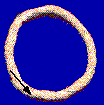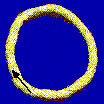 [t]
[t]

Knots and their polynomials
The Jones polynomial is calculated from an oriented knot diagram, that is, a 2-dimensional picture of a knot with overcrossings and undercrossings, and with a consistent set of directions indicated along the string. We will use the pictorial notation
 [t]
[t]
for the Jones polynomial of an oriented knot diagram.
The theory behind the Jones polynomial shows that it only depends on the knot as it exists in 3-dimensional space, and not on the particular diagram chosen to represent it (twisting a knot around in space can lead to very different diagrams). Also it does not depend on the orientation chosen in the diagram, so we can speak of ``the Jones polynomial of the knot.''
The algorithm for the calculation of the Jones polynomial from an oriented knot diagram is based on two principles.
1. The Jones polynomial assigns the value 1 to any oriented diagram representing the unknot.
 [t] =
[t] =  [t]= 1.
[t]= 1.
2. The skein relation: whenever three oriented diagrams differ only at one crossing point, their Jones polynomials are related by the equation
In words, this means that when three oriented diagrams are the same except at one crossing, t-1 times the Jones polynomial of the one with the upper-left-to-lower-right undercrossing minus t times the Jones polynomial of the one with the upper-left-to-lower-right overcrossing is equal to (t1/2-t-1/2) times the Jones polynomial of the one with two downward-oriented uncrossed strands.
We will calculate a Jones polynomial by repeated application of this relation.
Back to the previous knot page.
Back to the first knot page.